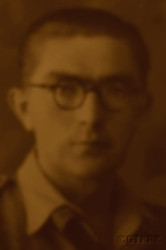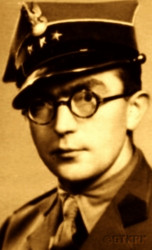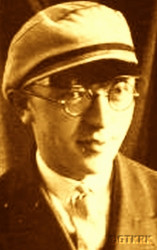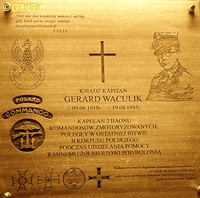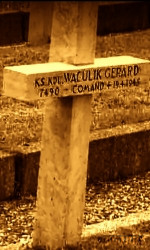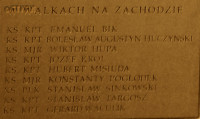Roman Catholic
St Sigismund parish
05-507 Słomczyn
85 Wiślana Str.
Konstancin deanery
Warsaw archdiocese, Poland
full list:
displayClick to display full list

searchClick to search full list by categories
wyświetlKliknij by wyświetlić pełną listę po polsku

szukajKliknij by przeszukać listę wg kategorii po polsku

Martyrology of the clergy — Poland
XX century (1914 – 1989)
personal data
surname
WACULIK
surname
versions/aliases
WATZULIK
forename(s)
Gerard
religious forename(s)
Fabian
function
religious cleric
creed
Latin (Roman Catholic) Church RCmore on
en.wikipedia.org
[access: 2014.09.21]
congregation
Order of Friars Minor OFMmore on
en.wikipedia.org
[access: 2013.05.19]
(i.e. Franciscans, Minorites)
diocese / province
Assumption into Heaven of the Blessed Mary province OFMmore on
pl.wikipedia.org
[access: 2014.08.14]
RC Military Ordinariate of Polandmore on
en.wikipedia.org
[access: 2014.12.20]
honorary titles
1939–1945 Star (United Kingdom)more on
en.wikipedia.org
[access: 2022.10.15]
Africa Star (United Kingdom)more on
en.wikipedia.org
[access: 2022.10.15]
Italy Star (United Kingdom)more on
en.wikipedia.org
[access: 2022.10.15]
Defence Medal (United Kingdom)more on
en.wikipedia.org
[access: 2022.10.15]
War Medal 1939–1945 (United Kingdom)more on
en.wikipedia.org
[access: 2022.10.15]
Monte Cassino Commemorative Crossmore on
en.wikipedia.org
[access: 2022.10.15]
„Cross of Valour”more on
en.wikipedia.org
[access: 2019.04.16]
„Army Medal for War 1939–45”more on
en.wikipedia.org
[access: 2019.04.16]
War Order of Virtuti Militari — Silver (5th Class)more on
en.wikipedia.org
[access: 2019.10.13]
date and place
of death
19.04.1945

Castel San Pietro Termetoday: Bologna prov., Emilia‐Romagna reg., Italy
more on
en.wikipedia.org
[access: 2024.12.13]
alt. dates and places
of death
Gaianatoday: Bologna prov., Emilia‐Romagna reg., Italy
more on
it.wikipedia.org
[access: 2020.07.31]
details of death
After German and Russian invasion of Poland in 09.1939 and start of the World War II, after start of German occupation, on 18.01.1940 decided to leave Panewniki — together with Fr Boguslav Palla, among others — to cross over to Hungary.
There started to minister as a chaplain in Polish refugees camp in Magyarcsanád and Szeged–Alsóközpont (Mórahalom).
On 26.02.1940 however managed to get to Yugoslavia where with Abp Alois Stepinac knowledge started to minister to Chroats in Zagreb.
Prob. on 15.06.1940 left Zagreb with other Poles, including aforementioned Fr Boguslav Palla and got transported — through Saloniki, Istambul, Aleppo and Beirut — to Latrun in Palestine, where landed on 03.07.1940.
There volunteered and joined Polish Armed Forces in the West forming in Syria.
Nominated chaplain of the Independent Carpathian Riflemen battalion.
Took part in Libya campaign of 1941‐1942, of Tobruk and Ain al‐Ghazala battles, among others.
Wounded — till 06.05.1942 in field hospital.
From 20.10.1942 chaplain of the field hospital of 3rd Carpathian Riflemen Division, part of 2nd Polish Corps led by Gen. Vladislav Anders.
Participant from 13.12.1943 of Italy liberation campaign — among others on Sangro and Rapido rivers, along German Gustav defense line, and on 24.04‐31.05.1944 Monte Cassino battle.
Next took part in Ancona battle on 01.06‐04.09.1944 and along Gotha line.
From 06.08.1944 chaplain of 3rd Carpathian Infantry Regiment and next from 04.01.1945 of 2nd Battalion of Motorised Commando, with which took part in battles of spring campaign aiming at liberation of Bologna, on Senio river among others.
One of the commendations stated: „Constantly staying in the combat sector, helped wounded soldiers, lifted the spirits of fighting soldiers and with wonderful attitude on the battlefield, set a personal example of courage and dedicated work”.
Killed by a German sniper's bullet when tending to the wounded Polish soldier in battles along Gaiana river, c. 25 km to the east of Bologna.
cause of death
warfare
perpetrators
Germans
sites and events
Ribbentrop‐MolotovClick to display the description, Pius XI's encyclicalsClick to display the description
date and place
of birth
09.08.1910

Piekary Śląskietoday: Piekary Śląskie city pov., Silesia voiv., Poland
more on
en.wikipedia.org
[access: 2021.04.02]
religious vows
27.01.1934 (temporary)
27.01.1937 (permanent)
presbyter (holy orders)
ordination
26.09.1937

Wronkitoday: Wronki gm., Szamotuły pov., Greater Poland voiv., Poland
more on
en.wikipedia.org
[access: 2021.06.20]
positions held
1940 – 1945
RC military chaplain — Polish Armed Forces (formed „in the West”), Polish Armed Forces — chaplain, in the rank of captain, i.a.: in 1945 of the 2nd Motorized Commando Battalion of the 2nd Polish Corps; 1944‐1945 of the 3rd Carpathian Infantry Regiment; 1942‐1944 of the field hospital of the 3rd Carpathian Rifle Division; 1941‐1942 of the Independent Carpathian Rifle Brigade
1937 – 1940
friar — Panewnikitoday: part of Ligota‐Panewniki district in Katowice, Katowice city pov., Silesia voiv., Poland
more on
en.wikipedia.org
[access: 2021.08.12] ⋄ St Louis the King and Confessor monastery, Franciscans OFM ⋄ St Louis the King and Confessor RC parish ⋄ Katowicetoday: Katowice city pov., Silesia voiv., Poland
more on
en.wikipedia.org
[access: 2021.08.12] RC deanery — parish vicar
1934 – 1937
student — Wronkitoday: Wronki gm., Szamotuły pov., Greater Poland voiv., Poland
more on
en.wikipedia.org
[access: 2021.06.20] ⋄ Theological Study (higher theological seminary), Annunciation to the Blessed Virgin Mary monastery, Franciscans OFM
1934
student — Osiecznatoday: Osieczna gm., Leszno pov., Greater Poland voiv., Poland
more on
en.wikipedia.org
[access: 2021.07.18] ⋄ Philosophical Study (higher theological seminary), St Valentine Priest and Martyr monastery, Franciscans OFM
21.01.1933 – 27.01.1934
novitiate — Wieluńtoday: Wieluń gm., Wieluń pov., Łódź voiv., Poland
more on
en.wikipedia.org
[access: 2021.07.18] ⋄ Annunciation to the Blessed Virgin Mary monastery, Franciscans OFM
1932 – 1933
student — Innsbrucktoday: Innsbruck‐Land dist., Upper Austria state, Austria
more on
en.wikipedia.org
[access: 2024.03.19] ⋄ Faculty of Law and State Science, Leopold and Francis University
1931 – 1932
student — Wrocławtoday: Wrocław city pov., Lower Silesia voiv., Poland
more on
en.wikipedia.org
[access: 2021.04.02] ⋄ Business Institute, University of Wrocław [i.e. University of Wrocław (since 1945) / Frederic Wilhelm University of Silesia (1911‐1945) / Royal University i.e. Breslau Academy (1816‐1911)]
24.04.1922 – 05.03.1931
pupil — Nysatoday: Nysa gm., Nysa pov., Opole voiv., Poland
more on
en.wikipedia.org
[access: 2021.04.02] ⋄ Minor Theological Seminary (Seraphic College), St Elizabeth of Hungary monastery, Franciscans OFM
others related
in death
PALLAClick to display biography Hermenegild (Fr Bogumil)
sites and events
descriptions
Ribbentrop‐Molotov: Genocidal Russian‐German alliance pact between Russian leader Joseph Stalin and German leader Adolf Hitler signed on 23.08.1939 in Moscow by respective foreign ministers, Mr. Vyacheslav Molotov for Russia and Joachim von Ribbentrop for Germany. The pact sanctioned and was the direct cause of joint Russian and German invasion of Poland and the outbreak of the World War II in 09.1939. In a political sense, the pact was an attempt to restore the status quo ante before 1914, with one exception, namely the „commercial” exchange of the so‐called „Kingdom of Poland”, which in 1914 was part of the Russian Empire, fore Eastern Galicia (today's western Ukraine), in 1914 belonging to the Austro‐Hungarian Empire. Galicia, including Lviv, was to be taken over by the Russians, the „Kingdom of Poland” — under the name of the General Governorate — Germany. The resultant „war was one of the greatest calamities and dramas of humanity in history, for two atheistic and anti‐Christian ideologies — national and international socialism — rejected God and His fifth Decalogue commandment: Thou shall not kill!” (Abp Stanislav Gądecki, 01.09.2019). The decisions taken — backed up by the betrayal of the formal allies of Poland, France and Germany, which on 12.09.1939, at a joint conference in Abbeville, decided not to provide aid to attacked Poland and not to take military action against Germany (a clear breach of treaty obligations with Poland) — were on 28.09.1939 slightly altered and made more precise when a treaty on „German‐Russian boundaries and friendship” was agreed by the same murderous signatories. One of its findings was establishment of spheres of influence in Central and Eastern Europe and in consequence IV partition of Poland. In one of its secret annexes agreed, that: „the Signatories will not tolerate on its respective territories any Polish propaganda that affects the territory of the other Side. On their respective territories they will suppress all such propaganda and inform each other of the measures taken to accomplish it”. The agreements resulted in a series of meeting between two genocidal organization representing both sides — German Gestapo and Russian NKVD when coordination of efforts to exterminate Polish intelligentsia and Polish leading classes (in Germany called «Intelligenzaktion», in Russia took the form of Katyń massacres) where discussed. Resulted in deaths of hundreds of thousands of Polish intelligentsia, including thousands of priests presented here, and tens of millions of ordinary people,. The results of this Russian‐German pact lasted till 1989 and are still in evidence even today. (more on: en.wikipedia.orgClick to attempt to display webpage
[access: 2015.09.30])
Pius XI's encyclicals: Facing the creation of two totalitarian systems in Europe, which seemed to compete with each other, though there were more similarities than contradictions between them, Pope Pius XI issued in 03.1937 (within 5 days) two encyclicals. In the „Mit brennender Sorge” (Eng. „With Burning Concern”) published on 14.03.1938, condemned the national socialism prevailing in Germany. The Pope wrote: „Whoever, following the old Germanic‐pre‐Christian beliefs, puts various impersonal fate in the place of a personal God, denies the wisdom of God and Providence […], whoever exalts earthly values: race or nation, or state, or state system, representatives of state power or other fundamental values of human society, […] and makes them the highest standard of all values, including religious ones, and idolizes them, this one […] is far from true faith in God and from a worldview corresponding to such faith”. On 19.03.1937, published „Divini Redemptoris” (Eng. „Divine Redeemer”), in which criticized Russian communism, dialectical materialism and the class struggle theory. The Pope wrote: „Communism deprives man of freedom, and therefore the spiritual basis of all life norms. It deprives the human person of all his dignity and any moral support with which he could resist the onslaught of blind passions […] This is the new gospel that Bolshevik and godless communism preaches as a message of salvation and redemption of humanity”… Pius XI demanded that the established human law be subjected to the natural law of God , recommended the implementation of the ideal of a Christian state and society, and called on Catholics to resist. Two years later, National Socialist Germany and Communist Russia came together and started World War II. (more on: www.vatican.vaClick to attempt to display webpage
[access: 2023.05.28], www.vatican.vaClick to attempt to display webpage
[access: 2023.05.28])
sources
personal:
pl.wikipedia.orgClick to attempt to display webpage
[access: 2012.11.23], www.encyklo.plClick to attempt to display webpage
[access: 2021.12.19], prowincja.panewniki.plClick to attempt to display webpage
[access: 2018.09.02], www.youtube.comClick to attempt to display webpage
[access: 2018.09.02]
original images:
www.youtube.comClick to attempt to display webpage
[access: 2018.09.02], prowincja.panewniki.plClick to attempt to display webpage
[access: 2018.09.02], prowincja.panewniki.plClick to attempt to display webpage
[access: 2018.09.02], www.facebook.comClick to attempt to display webpage
[access: 2024.12.13], www.youtube.comClick to attempt to display webpage
[access: 2018.09.02], www.katedrapolowa.plClick to attempt to display webpage
[access: 2014.01.16]
LETTER to CUSTODIAN/ADMINISTRATOR
If you have an Email client on your communicator/computer — such as Mozilla Thunderbird, Windows Mail or Microsoft Outlook, described at WikipediaPatrz:
en.wikipedia.org, among others — try the link below, please:
LETTER to CUSTODIAN/ADMINISTRATORClick and try to call your own Email client
If however you do not run such a client or the above link is not active please send an email to the Custodian/Administrator using your account — in your customary email/correspondence engine — at the following address:

giving the following as the subject:
MARTYROLOGY: WACULIK Gerard
To return to the biography press below:
 Click to return to biography
Click to return to biography








